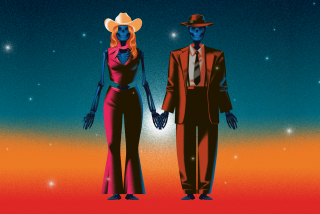Recapping a career beyond ‘Manchurian’
- Share via
If John Frankenheimer’s place in the pantheon of Hollywood auteurs seems a little shaky, it is largely because he had one of the longest dry spells of any major director. The one-time master of brute action and political paranoia, who died in 2002, produced a disproportionate amount of his notable work in the 1960s, a period that accounts for three of the four movies in the new Frankenheimer DVD set from United Artists. (The set is being issued as part of UA’s 90th-anniversary celebration, inaugurated with the release of a gargantuan if haphazardly curated 90-title box last month.)
Like Sidney Lumet, Frankenheimer came to the movies in the late ‘50s from live television, but his trademark style has little to do with the static claustrophobia of that medium. From the start, with his fondness for tricky set pieces and fluid camera maneuvers, he seemed like an obviously cinematic filmmaker -- although the opposite argument could also be made, if you were so inclined. In his seminal 1968 volume “The American Cinema,” critic Andrew Sarris pegged Frankenheimer as a TV hack who betrays his origins “by pumping synthetic technique into penultimate scenes as if he had to grab the audience before the commercial break.”
Even the best work from Frankenheimer’s prolific ‘60s heyday (he made 11 films that decade) has been unfairly overshadowed by the iconic status of “The Manchurian Candidate” (1962), one of the four films in the set. A satirical vision of the Cold War as hallucinatory nightmare, it opened during the Cuban Missile Crisis and seemed not only to distill the anxieties of the day but also eventually to foreshadow the political assassinations of the decade. United Artists and the film’s star, Frank Sinatra, a friend of John F. Kennedy, pulled it from circulation after the president’s death, and its long absence from movie screens -- it finally resurfaced in the late ‘80s -- only enhanced its mystique.
Frankenheimer’s two other major ‘60s films, neither one included here, are also adventures in paranoia: “Seven Days in May” (1964, Warner DVD) and “Seconds” (1966, Paramount DVD).
The UA set instead shows a few other sides of this adaptable if erratic director. “The Young Savages” (1961), the only title here new to DVD, is a politically aware social-issue drama (a mode Frankenheimer returned to in his ‘90s TV work, directing “Against the Wall,” a TV movie about the Attica prison riots, and a miniseries biopic of George Wallace). It is also his first pairing with his regular star, Burt Lancaster, who plays a district attorney prosecuting three teenage gang members for the murder of a blind Puerto Rican boy. Despite a memorably flashy opening sequence, which tracks the killers through the bustling streets of Harlem, the film devolves quickly into courtroom histrionics.
The remaining two films, “The Train” (1964) and “Ronin” (1998), are among the best examples of Frankenheimer’s action technique. Set in France at the tail end of the Nazi occupation, “The Train” pits Lancaster’s French railway inspector against Paul Scofield’s effete Nazi, who is trying to make off with a cargo of canvases by Renoir, Manet, Picasso, et al. The script, which was Oscar-nominated, is bogged down by ponderous musings on the relative value between human life and art (or rather, an art haul so vast it amounts to a cultural heritage), but the black-and-white cinematography and especially the action choreography are faultless. Instead of blithely defying the laws of physics, as thrillers are often obliged to do, the film fully conveys the speed and mass of its hulking locomotives.
“Ronin,” a European espionage jaunt and a late-career mini-comeback, doesn’t equal the brooding elegance of “The Train,” but it orchestrates its logistically daunting fender benders -- in particular, one relentless chase through Paris streets -- with flair and a respect for physical reality. The film was already an anomaly in the year of “Armageddon.” Seen today, it seems even more a poignant throwback, one last holdout in the age of the digitized blockbuster.
More to Read
Only good movies
Get the Indie Focus newsletter, Mark Olsen's weekly guide to the world of cinema.
You may occasionally receive promotional content from the Los Angeles Times.









